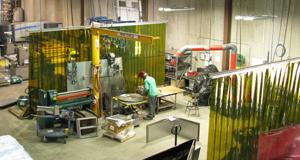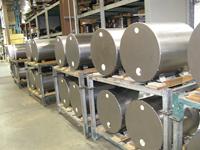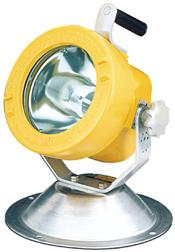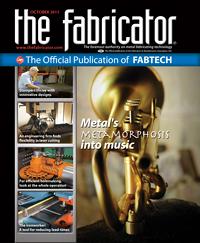Senior Editor
- FMA
- The Fabricator
- FABTECH
- Canadian Metalworking
Categories
- Additive Manufacturing
- Aluminum Welding
- Arc Welding
- Assembly and Joining
- Automation and Robotics
- Bending and Forming
- Consumables
- Cutting and Weld Prep
- Electric Vehicles
- En Español
- Finishing
- Hydroforming
- Laser Cutting
- Laser Welding
- Machining
- Manufacturing Software
- Materials Handling
- Metals/Materials
- Oxyfuel Cutting
- Plasma Cutting
- Power Tools
- Punching and Other Holemaking
- Roll Forming
- Safety
- Sawing
- Shearing
- Shop Management
- Testing and Measuring
- Tube and Pipe Fabrication
- Tube and Pipe Production
- Waterjet Cutting
Industry Directory
Webcasts
Podcasts
FAB 40
Advertise
Subscribe
Account Login
Search
Need a light--now?
Quick-response manufacturing shows promise for high-mix operations
- By Tim Heston
- October 20, 2011
- Article
- Shop Management

Figure 1: The fabrication cell at Phoenix Products has a punch press, a press brake, and welding stations.
In the corner of a conference room at Phoenix Products Co. sits an unassuming light fixture with a cast housing painted yellow, a bracket, and a formed sheet metal base. It’s industrial, utilitarian. People in the petrochemical field use them during planned shutdowns for cleaning tanks.
For these costly shutdowns, petrochemical companies need the lights delivered on time, every time. Over the past few years, Milwaukee-based Phoenix Products has gained significant market share in the segments it serves, and it’s mainly because of how quickly the manufacturer can respond. The lead-time for these light fixtures used to be eight weeks; now it’s two (see Figure 1).
One more thing: The company did it not by increasing capacity utilization—but by reducing it.
Lynn Benishek, materials manager, knew the old mindset. She would walk the floor and see people at the turret punch presses, hydraulic presses, press brakes, welding, and assembly areas working away furiously. If the machine wasn’t running, it wasn’t making money, right? The problem was, too many orders shipped late. In fact, though Benishek witnessed all that furious work, some days few if any products would be sitting near the loading dock, ready for delivery.
Today she walks the floor and sees some machines idle, but most days she also sees various finished goods near the loading dock. When she arrives the next morning, those finished goods are gone. Her point: Running machines flat out does not translate into making money; shipping more quality products in less time does.
What Improvement Methods Worked
In recent years company managers have delved into various improvement methodologies, including lean manufacturing. For Phoenix, lean thinking worked to a point, but only to a point, and the company’s background helps explain why.
Phoenix was founded more than a century ago as a printing shop. In the decades that followed the company launched a metal products division, which produced portable baking ovens for welding electrodes and lighting fixtures, among other products. Today Phoenix is best-known for its lighting products—fixtures for the architectural, mining, marine, and general industrial markets. The company also can customize products to suit customer needs—and all this has led to a seriously high-mix manufacturing environment. In all, Phoenix now has more than 20,000 SKUs and integrates more than 8,000 purchased items into its products. Some 92 percent of that product mix is build-to-order, driven by customer demand. Only 8 percent is build-to-stock.
In the 1990s Phoenix ran like a traditional manufacturing plant. It was stocked with purchased products, including castings from China. These products could have lead-times spanning months, so Phoenix’s purchaser always ensured plenty of safety stock was on hand. High-volume orders meant cheaper per-piece pricing, so the purchaser bought in bulk—and why not? Not only did the low price make the purchaser look good, many of the company’s key suppliers had weak on-time delivery rates. With such unpredictability, it’s no wonder Phoenix stocked as much as it could.
Machine efficiency ruled the day, which meant that operators avoided setups like the plague. This flooded the floor with work-in-process (WIP), and it took weeks for products to make their way through the shop. It was like rush hour (itself an ironic term). There were plenty of cars, but nothing was moving anywhere fast.
As CEO Scott Fredrick recalled, “We were making things in big batches to amortize the cost of the machine setups. We had continually lengthening lead-times, continually increasing inventory, and continually increasing labor and especially overtime costs.”
Compare this with today. The company’s metal service center—only a few miles away—makes daily stops to deliver only what the company needs, when it’s needed. The shop floor has minimal WIP, and though every machine may not always be running, products are moving.
Jeff Konkel, vice president of operations, pointed out the company’s sheet metal fabrication cell; it has two turret punch presses next to a press brake next to a welding area. Everyone in the work area is cross-trained to some extent. For instance, the welder can operate the punch press and press brake as needed, then return to the joining area and pick up a gas tungsten arc welding torch (see Figure 2). Together they ensure fast product flow through the cell. This also happens to be a union shop. According to sources, when it comes to these kinds of improvement efforts, including cross training, the union is completely onboard.
Is This Lean?
All this sounds as if the company has treaded far down the lean manufacturing path, but it hasn’t followed all elements of lean. Although the fabrication cell groups dissimilar machines, it isn’t dedicated to specific parts or even broad part families. The punch press operator can work on a dozen parts for a light fixture, and then switch to components for electrode-drying ovens.
Phoenix’s shop floor does have some attributes of lean manufacturing. The shop looks as if everyone takes 5S seriously; procedures are well-documented. Some work centers have screens that show assembly workers complete 3-D models and related documentation (see Figure 3). Working with so many SKUs, these employees must receive the right information at the right time.
Tools and materials are easy to find. In the assembly area and elsewhere, parts are placed near the point of use. All an assembler has to do is turn around, and he or she will find all the components needed to put together a product. Raw stock inventory also is minimal, replenished daily, and carefully managed (see Figure 4). The company also has streamlined material handling between work centers. Small batch sizes travel on carts or specially designed baskets between workstations. Few jobs wait for a fork truck.
So if this isn’t lean manufacturing, what is it?
It’s something called quick-response manufacturing, or QRM, a concept born in the 1990s at the University of Wisconsin-Madison. The developer of QRM, Rajan Suri, released a new book on the topic, It’s About Time, geared toward manufacturing executives. (For a review, click here.) Phoenix launched its first QRM projects in 2006. According to managers, QRM helped this high-mix operation transform into a place that could deliver in days instead of weeks—and eat up market share because of it.
“Traditional lean principles do overlap with QRM,” Fredrick said, “and we implemented a lot of lean manufacturing in our plant. But lean usually works for companies doing standard parts. QRM’s reason for being is to serve high-mix, low-volume manufacturers. That’s us. An order of 10 lights in certain markets can be a very nice order for us.”
QRM Ground Rules
Now Phoenix’s production abides by several QRM principles. First, the more time a product sits on the floor—even if it’s just sitting there, not being touched by human hands—the more it costs to make. During all this time, the company continues to pay wages, suppliers, utility bills, office expenses, sales expenses, and so forth. The longer it takes to ship products, the more payments continue to flow out; meanwhile fewer shipments over that same time period mean less cash is coming in. That’s not a good combination.
“When we looked at a light fixture, its touch time consisted of only about six hours,” Fredrick said. “But we’d wait six weeks to deliver it. Why did it take six weeks to ship if it only took six hours to build? In QRM, that difference is what we call ‘white time.’ Our machines were backlogged, making large batches of parts that really weren’t needed immediately. Meanwhile we weren’t making parts that people were screaming for—all just to save on setup.”

Figure 2: A cross-trained worker gas tungsten arc welds a light fixture component. Minutes before this employee set up and ran a press brake.
Batch Size and Part Flow
To reduce the time it took for products to flow through the shop, Phoenix reduced batch sizes, and as Benishek described, one of the first projects involved a cell making welding electrode-drying ovens. The company ships about 30 a week, but to avoid setups, a portion of the plant would spend an entire week making 80 or more ovens. If an order for a lighting fixture came in, that was too bad. This week the floor was making ovens. So that lighting fixture order—along with many others—sat like a bump on a log until those 80 ovens were fabricated and assembled. After that about 30 ovens shipped out the door, while the remaining 50 sat in finished goods inventory, tying up cash.
“We were tying up machines when we needed to be making other products,” Benishek said.
When the shop reduced batch sizes to 30, good things happened. Yes, people were setting up machines more often, but more products were shipping out the door. “By reducing the batch sizes of components and our assemblies, we reduced our machine time in our fabrication area,” Benishek said, “and we also reduced our shipping time to customers.” This happened because of the reduced waiting time. Those other orders weren’t sidelined while massive batches of ovens were being finished (see Figure 5).
Various improvement techniques, including lean, preach the virtues of quick changeovers. Otherwise, with small batches workers spend too much time setting up, not enough time producing parts, the very thing those huge batch sizes were meant to prevent. Phoenix does work on quick-changeover improvements, but as sources explained, quick- changeover techniques have been icing on the cake—though it hasn’t been the actual cake.
“Reducing setup time is always a good idea,” Fredrick said. “But when we looked at the actual numbers, we realized we almost obsessed over setup times. Considering all the labor costs, setup time isn’t as large as you make it out to be sometimes. Of all the labor in our factory, so much of it is indirect labor, maintenance, and warehousing. Meanwhile less than 10 percent of our total direct labor cost was spent on setups.”
Calculating Capacity Utilization
What really has taken the cake has been running work centers at lower average capacity levels.
“We now plan to run at 75 percent utilization instead of 85 or 95 percent utilization,” Fredrick explained.
He added that this happened in part because everyone was working only on orders due now; they weren’t making extra and sending those goods to finished goods inventory. This did create more setup, and direct labor costs did increase. “But this was more than offset in decreases in indirect labor, expediting, emergency shipments, and overtime. This also gave us a lot of time in the schedule to respond to orders that we suddenly were getting, because we were delivering in two weeks instead of six weeks.”
Note that the company treats the capacity utilization metric a bit differently. If a shop reduces batch sizes and increases the frequency of setups, it naturally reduces utilization, if you measure a machine’s capacity utilization as time spent actually producing parts.
Following some of the principles of QRM, Phoenix takes a different approach. Managers define utilization as a machine’s ability to take on an increased work load. When operators are setting up a machine, it’s in use and not available for anything else. The machine is being “utilized” for setup. If a machine is undergoing intensive maintenance and so can’t be used for anything else, it is being “utilized” for maintenance.

Figure 3: Screens in an assembly cell allow workers to pull up complete 3-D models and related information for the job at hand.
Phoenix managers determine capacity utilization by calculating the amount of available time a work center has to take an unexpected job, and then subtracting that from 100 percent. These days Phoenix’s work centers on average are available 25 percent of the time to take on unplanned work; hence, its capacity utilization is 75 percent. This allows these work centers to handle the variability of a high-mix operation.
High-level Scheduling
“[The schedule] used to have a long list of about 100 priorities,” Benishek said. Working from that long list, machine operators sometimes would choose, say, three parts with identical setups, even though two of them weren’t due for several weeks. This meant the machine churned out parts, and only a third would move on downstream; the rest would just sit as WIP.
For scheduling, the company still uses information generated by its materials resource planning (MRP) system, but at a high level. The software doesn’t schedule down to minutia. Instead, workers in each cell receive a sheet showing which jobs are due immediately—the “due now” time bucket. On the list may be about two to four priorities, but that’s about it. The workers in each cell determine the order and work flow of those four orders.
The company operates about a half dozen QRM cells, including that fabrication cell. Each cell has multi-functional resources, carrying a workpiece through multiple setups of manufacturing. Most products do involve some type of fabrication, so the fabrication cell serves “internal customers,” those working downstream operations. From there products flow to various QRM assembly cells devoted to broad product families for defined market segments—mining equipment, marine, architectural, industrial, and so on.
Key to designing these cells, Fredrick explained, was giving workers access to more machines so they could carry a component through multiple stages of production all in one area (see Figure 6). In the assembly area, for instance, workers would perform specific operations and then pass the workpiece down the line. This may work for low-mix assembly, but it slowed things considerably for Phoenix’s high-mix operation. “We moved more machines into these assembly cells so workers could do multiple operations in one place,” he said. “We wouldn’t have another work order and more wait time—or as we say in QRM, more ‘white time.’”
The Value of People
Sources agreed that the most challenging component of QRM was a cultural one. Employees had been taught that machine efficiencies and uptime ruled. Producing smaller batches was a hard pill to swallow. “It was all so counterintuitive, and counter to how we were all trained and how we cost things,” Fredrick said. Overcoming that cultural hurdle, he added, has really paid off. “Right now we’re above our previous highs experienced in 2007 and 2008.”
Like most companies, Phoenix experienced tough times during the recession, but it had no mass layoffs. Why? Benishek didn’t give the expected answer, that people are a company’s greatest asset—a buzz phrase that, while true, has been made hollow by the rampant downsizing of the Great Recession.
Instead, she said this: “People have capacity too.”
Their knowledge, experience, and cross training make them incredibly valuable, and if a company downsizes during a recession, it can take a long time to rehire and retrain. Because Phoenix retained most of its workforce, it has been able to maintain its quick response during the economic recovery and, because of it, gained more business.
Benishek also was careful not to say that more training increases a worker’s capacity. This may be true to a point, especially for entry-level workers, but there are still only so many hours in a workday. Pushing people to maximum capacity is just as bad (if not worse) as pushing a machine to the limit—a recipe for backlogs, overtime, and part-flow traffic jams. This was why, in early 2008, just months before the financial crisis, the company hired an additional 10 workers in the assembly area.

Figure 4: Phoenix’s steel supplier delivers small batches of sheets daily—just what the company needs, no more and no less.
Phoenix managers choose machinery investments carefully. For instance, the shop still runs a bank of manual spinning lathes; volumes just aren’t high enough to justify CNC spinning centers. But the company still has made significant machinery purchases in recent years, including a new band saw and a reconditioned turret punch press.
Phoenix needed more machines and people to meet demand without driving up capacity utilization into dangerous territory—again, above 75 percent. Pushing capacity utilization to the limit is like creating a rush hour of parts on the floor. Jobs are released, go down the entry ramp, and get stuck in stop-and-go shop floor traffic.
Benishek held up a chart showing revenue produced by each worker per hour. After the company hired more people, revenue per worker-hour did not drop, as expected. Instead, it jumped—significantly. This happened, she explained, because those additional workers could ship more products in less time, including less overtime.
Speeding the Supply Chain
The stock area has shrunk significantly in recent years—and that, of course, has been on purpose. The company no longer judges suppliers on price alone, but also turnaround and quality. Small, frequent deliveries are better than a high-volume shipment.
Phoenix rates its suppliers quarterly and works with them to reduce response times. For items such as castings, the company does work with Asian suppliers that, while response has improved, still have relatively long lead-times. It simply takes time to cross an ocean. Nevertheless, these components are tied to products with relatively stable demand, so a long-lead-time supplier works.
But for other products, long supplier lead-times are detrimental, even if that supplier has a stellar on-time delivery rate. While waiting weeks for a component, an engineering change or demand fluctuation might occur, and this leaves Phoenix in one of three scenarios: The company may receive incorrect components that are sent to scrap; they may have too many products, so the company incurs excess inventory that may become obsolete; or they might not receive enough products, so Phoenix may end up losing orders—or even customers. Any scenario adds up to serious costs that may eliminate the price difference between domestic and overseas suppliers.
“This is why we are trying to source regionally when we can,” Benishek explained.
The concepts of QRM are also spreading one step down the supply chain. Phoenix’s customers no longer need to hold inventory but instead order from Phoenix just what they need. The result: Customers can order more frequently and in smaller quantities. “It’s made us much more of a preferred supplier,” Fredrick said, “because we’re more reliable on deliveries, and we don’t insist on high volumes.”
Advantages of Time Splicing
For certain outside processes, including powder coating, Phoenix practices time sharing or time splicing. The company buys a weekly time slot at a custom coating facility—whether Phoenix needs anything powder-coated or not. This gives the powder coating shop a predictable revenue stream. In return, the shop gives Phoenix access to its powder coat line at the same time every week, and the coater is happy to run various colors Phoenix might need—immediately.
“We know that Thursday afternoon that powder coating line is ours,” Fredrick explained. That immediate response pays for itself and then some, he added, because metal parts no longer sit for days waiting for a powder coater to run a certain color.

Figure 5: Before the batch size reduction, electrode-drying oven manufacturing tied up work centers for a week, pushing more urgent orders behind schedule.
No Wasted Space
The moment I walked into Phoenix’s front lobby, I noticed something: no lobby—just a few chairs and a small display of the company’s lighting and oven products in the corner. I opened the door and found myself standing in front of cubicles full of people selling, planning, and engineering products. The company also has no front receptionist. An employee in the nearest cubicle stopped what he was doing, greeted me, picked up his phone, and called Jeff Konkel.
“When we moved to this new facility several years ago, we went from several hundred thousand square feet down to 60,000 square feet,” Konkel said. “We had a major culture change, and we tried to be more efficient with our space.”
Reducing space seems counterintuitive for a growing business, but large workspaces cost money to maintain. “We try to use every cubic inch we can,” Konkel added. “We’ve kept our operating costs down by not building bigger buildings, and not having to heat and maintain those buildings.” The place isn’t cramped at all. In fact, aisles on the floor are clear of WIP.
The manufacturing space shows how dramatically the culture has changed at Phoenix. A big building doesn’t make a product any better or help deliver it faster. In manufacturing, people and machines do the real work and so provide the real value. For manufacturing overall, a sector with an unfortunate reputation for mass layoffs and weak job security, that’s a good message.
About the Author

Tim Heston
2135 Point Blvd
Elgin, IL 60123
815-381-1314
Tim Heston, The Fabricator's senior editor, has covered the metal fabrication industry since 1998, starting his career at the American Welding Society's Welding Journal. Since then he has covered the full range of metal fabrication processes, from stamping, bending, and cutting to grinding and polishing. He joined The Fabricator's staff in October 2007.
subscribe now

The Fabricator is North America's leading magazine for the metal forming and fabricating industry. The magazine delivers the news, technical articles, and case histories that enable fabricators to do their jobs more efficiently. The Fabricator has served the industry since 1970.
start your free subscription- Stay connected from anywhere

Easily access valuable industry resources now with full access to the digital edition of The Fabricator.

Easily access valuable industry resources now with full access to the digital edition of The Welder.

Easily access valuable industry resources now with full access to the digital edition of The Tube and Pipe Journal.
- Podcasting
- Podcast:
- The Fabricator Podcast
- Published:
- 04/16/2024
- Running Time:
- 63:29
In this episode of The Fabricator Podcast, Caleb Chamberlain, co-founder and CEO of OSH Cut, discusses his company’s...
- Trending Articles
AI, machine learning, and the future of metal fabrication

Employee ownership: The best way to ensure engagement

Steel industry reacts to Nucor’s new weekly published HRC price

Dynamic Metal blossoms with each passing year

Metal fabrication management: A guide for new supervisors

- Industry Events
16th Annual Safety Conference
- April 30 - May 1, 2024
- Elgin,
Pipe and Tube Conference
- May 21 - 22, 2024
- Omaha, NE
World-Class Roll Forming Workshop
- June 5 - 6, 2024
- Louisville, KY
Advanced Laser Application Workshop
- June 25 - 27, 2024
- Novi, MI




























